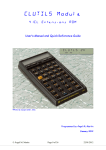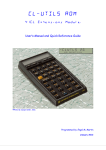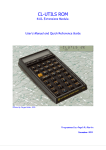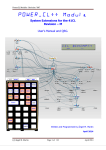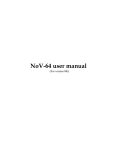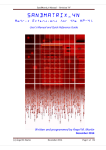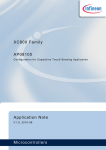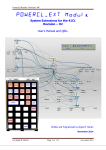Download Sandbox 3D – The last HP-41 Plug
Transcript
#,54),31/-
&/([WHQVLRQV0RGXOH
User’s Manual and Quick Reference Guide
©Photo By Jürgen Keller, 2011.
Programmed by Ángel M. Martin
December 2011
This compilation revision 2.F.02
Copyright © 2011 Ángel Martin
Published under the GNU software licence agreement.
Original authors retain all copyrights, and should be mentioned in writing by any part utilizing this
material. No commercial usage of any kind is allowed.
Screen captures taken from V41, Windows-based emulator developed by Warren Furlow.
See www.hp41.org
CLWRITE Source Code written by Raymond Wiker.
Cover photo © Juergen Keller, 2011.
Inside photos © Geoff Quickfall, 2011
Acknowledgment.- This manual and the CLUTILS module would obviously not exists without the
41CL. Many thanks to Monte Dalrymple for the development of the amazing CL board.
© Ángel M. Martin
Page 1 of 30
30/12/2011
CL-UTILS Module
Extension Functions for the 41CL
Table of Contents.
1. Introduction.
1.1.
1.2.
A word of Caution.
The Functions at a glance
2. The functions in detail
2.1
2.2
2.3
2.4
Function Launchers
Catalogues and CATalogs
Interrogating the MMU
A wealth of a Library
3. HEPAX and Security
3.1.
3.2.
Configuring the HEPAX system
Security Functions
4. Advanced Territory
4.1.
4.2.
Using Page #4
Calculator Flash Backup & Restore
5. Other Extensions
5.1 Alpha and Display Utilities
5.2
5.3
Other Utilities
Farewell.
6. Appendixes.
© Ángel M. Martin
5
6
7
9
12
13
14
16
17
17
19
20
21
Page 2 of 30
30/12/2011
© Ángel M. Martin
Page 3 of 30
30/12/2011
CL-UTILS Module
Extension Functions for the 41CL
1. Introduction.
Without a doubt the 41CL can be considered in many ways to be the pinnacle of the HP-41 system. It
comes with a well thought-out function set to manage its capabilities, from the basic to the more
adventurous ones – which have inspired the writing of yet further extensions to that capable toolset.
This collection is designed to enhance and complement the YFNS function set, providing easier access
to the many powerful capabilities of the 41CL platform. Some are function launchers, grouping several
functions by their area of functionality into a single, prompt-driven one – like it’s the case for the
Plug/Unplug functions, the Baud rate, TURBO and MMU settings functions. A launcher of launcher sits
atop these, providing quick access to 27 YFNS functions from a single key assignment.
Some other extend the functionality by providing new features and more convenient alternative to
manual tasks. Examples of these are:
-
A fully-featured ROM library CATALOG system, allowing direct plugging into the port of choice
The Page Plug functions (alternative to the Port ones), including routines to handle page #4.
Programs to backup and restore the complete calculator contents to/from Flash
HEPAX configuration and set-up, making the HEPAX integration a simple and reliable affair.
Security functions to password-protect your machine from prying hands.
Other housekeeping functions roundup the set, making for a total of 41 functions tightly packed into a
4k ROM. This is a design criterion, as the small footprint of the module makes it ideal to share with
other utility packs, most notoriously the CCD OS/X (or its alter-ego AMC OS/X) for the ultimate control
- so save some small exceptions there is no duplication between these two.
A word of caution.
As wise men remind us all, “with power comes responsibility”. Indiscriminate usage of some of these
functions can have unpleasant consequences, ranging from unexpected results and easy-to-recover
machine lock-ups to more serious ones involving loss of Flash sectors or even electrical damage in the
worst scenario. Functions have some built-in protection to ensure that they’re used properly, but they
are not absolutely foolproof in that such protection can always be circumvented. So beware, and as
general rule “if you don’t understand something, don’t use it”.
To help you with this the more dangerous functions are marked with the WARNING sign all
throughout this manual. Avoid them if you’re not absolutely sure that you know what they are for, and
fully understand their operation. And always, always have fresh batteries on when using the Flash
backup!
It had to be said – so now that we got it out of the way we’re ready to dive into the CL UTILS
description and usage example. May you have a nice ride!
© Ángel M. Martin
Page 4 of 30
30/12/2011
Function index at a glance.
And without further ado, here’s the list of functions included in the module:
#
1
2
3
4
5
6
7
8
9
10
11
12
13
14
15
16
17
18
19
20
21
22
23
24
25
26
27
28
29
30
31
32
33
34
35
36
37
38
39
40
41
Function
-CLUTLS 2E
?MMU
ΣCLF _
BAUD _
CLLIB _
MMU _
MMUCAT
PLUGG _
PLUGG? _
PLUGGX
PLG#4 _
PLUG _
ROMLIB
UPG#4
TURBO _
UPLUG _
Y1SEC
YBSP
YCL>
YCLYFNZ?
YINPT _
YRALL
YSWAP>
YSWAPYWALL
-SYS/EXT
ADRID
BFCAT
BLCAT
CDE
DCD
DTOA
DTST
HEPINI
"HPX4"
"HPX8"
"HPX16"
SECURE
UNLOCK
XPASS
Functions
Functions
Functions
Functions
in
in
in
in
Description
Module Header
MMU Status Yes/No
Global Launcher
Baud functions launcher
CL ID Library
MMU functions launcher
MMU Catalogue
Plug Page
Page Location MMU
Plug Page by X
Page#4 Plug
PLUG functions launcher
ROM Library
Clears MMU entry for page #4
TURBO functions launcher
UPLUG functions Launcher
One-second delay
ALPHA back Space
Clears string from ">"
Clears string from hyphen
Page location of YNFS
Y Input
Y-Read-ALL
Swaps both sides of ">"
Swaps both sides of hyphen
Y-Write-ALL
Section Header
Address ID
Buffer Catalogue
Block Catalogue
Code
Decode
Display to ALPHA
Display Test
HEPAX FileSys Init
HEPAX FileSys Init - CL
HEPAX FileSys Init - CL
HEPAX FileSys Init - CL
Enable password lock
Disable password lock
Change password
Inputs
n/a
None
Prompts "B:M:P:T:U"
Prompts "1:2:4:9"
Prompts "A-Z"
Prompts "C:D:E:?"
None
Prompts for page
Prompts for page
Page# in X
Prompts "F:L:S"
Prompts for location
Displays all ROMs
None
Prompts "X:2:5:1:0:,:?"
Prompts for location
None
String in ALPHA
String in ALPHA
String in ALPHA
None
None
None
String in ALPHA
String in ALPHA
None
n/a
Flash address in Alpha
None
None
HexCode in ALPHA
NNN in X
Display contents
None
# pages in X, first page in Y
None
None
None
None
Asks for password
Asks old/new passwords
Output
n/a
YES/NO, skip if false
Launches selected Launcher
Launches selected function
Starts listing at selected letter
Launches selected function
Sequential list of MMU Entries
Plugs ROM in page
content of MMU entry for page
Plugs ROM in page
Selected ROM plugged
ROM with ID in ALPHA is plugged
Sequential list of ROM ID's
MMU entry cleared
Launches selected function
Location is removed from MMU
1-sec delay
Deletes rightmost character
Clears from ">" char to the right
Clears from "-" char to the right
Location in MMU
HEX entry plus control chrs.
Reads Calculator/MMU from Flash
Alpha swapped around ">"
Alpha swapped around "-"
Writes Calculator/MMU to Flash
n/a
ROM ID in Alpha
Shows present buffers
Lists block contents
NNN in X
Hex Code in Alpha
Text in Alpha
Shows display all lit up
Initializes HEPAX File System
Configures 4k HEPAX on CL
Configures 8k HEPAX on CL
Configures 16k HEPAX on CL
Sets SECURE mode ON
Sets Secure mode OFF
Password is changed
BLUE are all in MCODE.
BLACK are MCODE entries that call FOCAL programs.
“QUOTES” italics are FOCAL programs.
RED denote prompting entries.
© Ángel M. Martin
Page 5 of 30
30/12/2011
2. The functions in detail.
The following sections of this document describe the usage and utilization of the functions included in
the CL-UTILS module. While some are very intuitive to use, others require a little elaboration as to
their input parameters or control options, which should be covered here.
/$81&+(56
2.1 Function Launchers.
The table below lists the launchers by function groups:
Index
1
2
3
4
5
Function
BAUD
MMU
TURBO
PLUG
UPLUG
Warnings
None
None
None
Light
Light
Description
Calls BAUD12, BAUD24, BAUD48, or BAUD96
Calls MMUDIS, MMUEN, or MMU?
Calls the corresponding TURBOxx function
Prompts for port location. Enter L/U first (when needed)
Prompts for port location. Enter L/U first (when needed)
6
ΣCLF
None
Launcher of Launchers -> invokes any of the five above
When you assign ΣCLF to any key that alone will give you access to more that 25 functions from that
single key – an effective way to make it compatible with other existing key-assignments, saving
memory (KA registers) and time. So go ahead and get comfortable with that arrangement as your
baseline.
Prompting functions use a technique called partial key entry, dividing the data entry in two (or more)
parts. The keyboard is also re-defined, in that just those keys corresponding to the appropriate
options are active. The cues in the prompt will offer you indication of which keys are active on the
keyboard, and typically are intuitive enough to figure out in each case.
options for: none, 2x, 5x, 10x, 20x, 50x, and ?
Use “0” for 20x, Radix for “50” - as 2 and 5 are already taken for 2x and 5x speeds.
In general all launchers behave in a similar manner.
-
The Back Arrow key will either cancel out entirely or remove partial entries;
Non-active keys will blink the display and maintain the prompt
Holding down the last key briefly shows the invoked function name – visual feedback.
This will be followed by NULL if kept depressed long enough – last chance to bail out.
Launchers are not programmable per-se – but:
They can be used in PRGM mode to enter the called-upon function as a program line.
© Ángel M. Martin
Page 6 of 30
30/12/2011
The PLUG and UPLUG launchers don’t offer any cues in the prompt – and therefore deserve special
consideration. The picture below shows the convention for the external pages of the 41:
Valid entries for the prompt are:
1, for port 1 – comprising pages 8 and 9
2, for port 2 – comprising pages A and B
3, for port 3 – comprising pages C and C
[L], to flag a LOWER half-port condition, followed by the port number
[U], to flag an UPPER half-port condition, followed by the port number
For the (U)PLUG cases the prompt completes either when the number 1-4 or the letter {G,P,H} is
entered, and the corresponding function is launched.
For half-port (or 4k) modules use the L/U keys first in the (un)plugging prompts, then the port
number. These keys act as toggles when pressed sequentially, replacing each other in the display
upon repeat usage. Also during these events pressing BackArrow removes the half-port condition and
returns to the main prompt.
Remember that plugging a module into the “wrong” port location can create minor issues (or major
havoc) if you’re overwriting some/part of the machine’s configuration. A good example is overwriting
YFNS itself, or a HEPAX RAM block. Always make sure the destination is safe – using BLCAT, the
standard CAT2 or better yet the CCD CAT’2.
Also valid entries are :
[H], for page #7 – the HP-IL reserved page
[P], for page #6 -- the Printer reserved page
[G], for page prompt 6-F – effectively calling the PLUGG(?) functions
Caution.Both PLUG/UNPLUG offer all the 14 available choices in YFNS, including (U)PLUGP and (U)PLUGH.
Exercise extra caution with those two locations, as they may be used by system extensions like Printer
or HP-IL. Page #6 in particular has more strict demands on the ROM layout that makes it non-suitable
for the majority of ROMS. Also because pages #6 and #7 on the CL don’t support bank-switching,
they unfortunately aren’t a good place for the HEPAX ROM.
© Ángel M. Martin
Page 7 of 30
30/12/2011
&$7$/2*6
2.2.
CATALOGS, CATALOGUES…
The additional CATalogs are as follows:
Index
1
2
3
4
5
Function
BLCAT
BFCAT
MMUCAT
ROMLIB
CLLIB _
Warnings
None
Light
None
Light
Light
Description
Borrowed from the HEPAX ROM – shows the 4k-blocks contents.
Lists those elusive buffers present in the system.
Lists the MMU mappings into each block.
List the ROM Library ID’s available in Flash.
Same as above with an Alpha prompt for beginning section
If you’re like me you’ll like to have good visibility into your machine’s configuration. With its ROM
Library and MMU settings the CL adds a few dimensions to the already rich 41CX system – and the
goal is to have equivalent catalogue functions to review the status and options available.
Each CATalog has its own idiosyncrasies, but in general they feature single-step modes, and have “hot
keys” to allow for specific actions – like deletion of buffer, navigation shortcuts, and direct plugging of
ROMs into a port. This makes chores like searching for the correct syntax and plugging a module from
the library a trivial task.
Both BLCAT and BFCAT are not strictly related to the CL, and will also work on a standard 41.
Obviously MMUCAT is only meaningful for a CL machine, and will return all zeroes if the CL board is
not installed.
CATalog functions are notoriously complex and take up a significant amount of space – yet you’d
hopefully agree with me that the usability enhancements they provide make them worthwhile the
admission price.
2.2.1. Block CATALOG
BLCAT
Block Catalog
Author: VM Electronics
Source: HEPAX Module
Lists the first function of every non-empty ROM block (i.e. Page), starting with Page 3 in the 41 CX or
Page 5 in the other models (C/CV). The listing will be printed if a printer is connected and user flag 15
is enabled.
-
Non-empty pages will show the first function in the FAT, or “NO FAT” if such is the case
Empty pages will show the “NO ROM” message next to their number.
Blank RAM pages will show “QUASI RAM”, indicating their RAM in ROM space character.
No input values are necessary. This function doesn’t have a “manual mode” (using R/S) but the
displaying sequence will be halted while any key (other than R/S or ON) is being depressed,
resuming its normal speed when it’s released again.
© Ángel M. Martin
Page 8 of 30
30/12/2011
2.2.2. Buffer CATALOG
BFCAT
[D]
[H]
Buffer CATalog
Deletes Buffer
Decodes Header register
Hot keys: R/S, SST, SHIFT, D, H
In manual mode
In manual mode
This function is very close to my heart, both because it was a bear to put together and because the
final result is very useful and informative. It doesn’t require any input parameter, and runs
sequentially through all buffers present in the calculator, providing information with buffer id# and its
size.
41 buffers are an elusive construct that is mainly used for I/O purposes. Some modules reserve a
memory area right above the KA registers for their own use, not part of the data registers or program
memory either. The OS will recognize those buffers and allow them to exist and be managed by the
“owner” module – which is responsible to claim for it every time the calculator is switched on.
A good example is the Time module, which uses it to store the alarms data.
Each buffer has an id# number, ranging from 1 to 14. Only one buffer with a given id# can exist, thus
the maximum number present at a given time is 14 buffers – assuming such hoarding modules would
exit – which thankfully they don’t.
The table below lists the well-known buffers that are possibly to be found on the system:
For instance, plug the AOSX module into any available port. Then type PI, SEED, followed by BFCAT
to see that a 2-register buffer now exists in the 41 I/O area – created by the SEED function.
id# = 5, buffer size =2, properly allocated.
Suppose you also change the default word size to 12 bits, by typing: 12, WSIZE. This has the effect
of increasing the buffer size in one more register, thus repeating BFCAT will show:
id# = 5, buffer size = 3, properly allocated.
© Ángel M. Martin
Page 9 of 30
30/12/2011
Say now that you also plug the 41Z module into a full port of your CL. Just doing that won’t create the
buffer, but switching the calculator OFF and ON will – or alternatively execute the -HP 41Z function.
After doing that execute BFCAT again, then immediately hit R/S to stop the listing of the buffers and
move your way up and down the list using SST and BST. You should also see the line for the 41Z
buffer, as follows:
id#=8, buffer size = 12, properly allocated.
If the module is not present during the CALC_ON event (that’s to say it won’t re-brand the buffer id#)
the 41 OS will mark the buffer space as “reclaimable”, which will occur at the moment that PACKING
or PACK is performed. So it’s possible to have temporary “orphan” buffers, which will show a question
mark next to the id# in the display. This is a rather strange occurrence, so most likely won’t be shown
– but it’s there just in case.
BFCAT has a few hot keys to perform the following actions in manual mode:
1. R/S stops the automated listing and toggles it with the manual mode upon repeat pressings.
2. [D] – for instant buffer deletion – there’s no way back, so handle with care!
3. [H] - to decode the buffer header register. Its structure contains the buffer ID#, as well as
some other relevant information in the specific fields - all buffer dependent.
4. [SHIFT] to flag the listing to go backwards – both in manual and auto modes.
5. SST and BST to move the listing in manual mode, until the end (or beginning) is reached
6. BackArrow to cancel out the process and return to the OS.
Like it is the case with the standard Catalogues, the buffer listing in Auto mode will terminate
automatically when the last buffer (or first if running backwards) has been shown. In manual mode
the last/first entry will remain shown until you press BackArrow or R/S.
Should no buffers are present, the message ”NO BUFFERS” will be shown and the catalog will
terminate. Note also that the catalogue will not be printed - being shown only on the display.
Photo courtesy of Geoff Quickfall.
© Ángel M. Martin
Page 10 of 30
30/12/2011
2.2.3. Interrogating the MMU.
MMUCAT
ADRID
FYNZ?
PLUGG?
MMU CATalogue
Gives ROM id# from ADR
FYNS Location Finder
ROM id# in page by X
MMUCAT is really a FOCAL
to be confused with the
programmable. The idea is
showing either the ROM id#
No inputs
Expects string in Alpha
No inputs
Prompts for page#
Valid inputs are 4, 6-F
program that drives the function ADRID, the real engine behind it – not
capital city of a country I know quite well. ADRID is obviously
simple: produce a list of the MMU mappings into the different pages,
or the address (Flash or SRAM) currently mapped to the port.
A loop is executed starting on page #4, and up until page #F. Each iteration retrieves (pokes more
appropriately) the address written into the corresponding MMU register, then searches it against the
internal ROM id# table written into the CL_UTILS module. More about this later.
Note that full-port modules will return the ROM id# attached to the lower half, and the address to the
upper half. RAM MMU entries will return the corresponding RAM address.
While similar to the CAT2 concept, this really has an MMU-oriented perspective of things, and thus is
purely a 41 CL feature – it’ll render all entries zero if used on a “regular” 41. The program listing is
rather simple – as ADRID does all the weight lifting under the hood:
A related function is YFNZ?, which returns the page number the YFNS is currently plugged in. This
can come very handy in your programs to avoid overwriting it with other modules – as we’ll see in the
HEPAX configuration routines.
Another related function is PLUGG? - It interrogates the MMU to find out which module is plugged
into a given page – the input to the function placed in X. This is all page-driven, and not based on
the port number. There is no restriction in the input to the page number, however the returned values
for pages 0,1,2,3, and 5 don’t quite have the same meaning.
PLUGG? Also uses ADRID to decode the string returned by YPEEK – which provides the MMU
address mapping the corresponding page. In the YFNZ? case there’s no need to look up in the ROM
id# table since we know what we’re looking for – just need to check all pages looking for that specific
string.
© Ángel M. Martin
Page 11 of 30
30/12/2011
2.2.4. A wealth of a Library.
ROMLIB
CLLIB
[P]
[A]
ROM Library
CL Library
Invokes PLUG _
Copies id# shown to Alpha
No inputs
Prompts for A-Z
One of the most notable features of the CL is its extensive ROM image library, allowing you to plug
almost any conceivable module ever made (of which I have contributed a few) into your 41CL just by
using one of the PLUGxx functions. The input syntax requires that the correct ROM ID string be
placed in Alpha, and certainly there are a few of those to remember – and rather similar to each other
since the string is only 4 characters long.
These two functions come to the rescue – by providing an alphabetical listing of all the module ID’s so
you can review them and –eventually – plug the ROM directly from the catalogue, for convenience
sake.
ROMLIB starts the listing at the top of the list, whereas CLLIB prompts for an alphabetical section, A
to Z. Choosing “A” here is of course equivalent to executing ROMLIB. Both catalogues can run in
auto mode of can be stopped using R/S, and then the listing can proceed in manual mode using SST
and BST as you can expect.
It is in manual mode where you can use the other shortcuts or “hot keys”, as follows:
-
ENTER^ skips to the next section (or previous if running backwards)
[A] will copy the id# shown to Alpha
[P] will exit the catalog and invoke the PLUG_ function launcher
[SHIFT] changes the direction of the listing, backwards <-> forwards
BackArrow will cancel out the catalog.
The enumeration terminates in auto mode when the last ROM id# (or first one if running backwards)
has been reached. Also keeping any key depressed in RUN mode will halt the sequence displaying
until it’s released again, so it’s easier to keep tabs with the enumeration.
The same considerations made about plugging modules can be made here – be careful not to
overwrite anything you’re using with a new ROM image, as there’s no check whether the target
location is already used or not.
As you can imagine there is a lot of code sharing between ADRID and these two ROM library
catalogue functions. Fundamentally they all use a ROM id# table within the CL-UTILS ROM to look up
for the string, and fetch the address in Flash of the corresponding image. This table is quite long,
occupying almost 1k in the ROM – yet worth every byte.
The “A-Z” prompt entry in CLLIB is a refinement of the same idea: it provides a handy shortcut to
start your search in the appropriate section, so there’s no need to review all the preceding ones –
which can be very lengthy considering the sheer number of them, even if you used ENTER^ to skip
sections. The implementation is quite nice, even if it’s the author who says it – have a look at the
CLUTILS_Blueprint if you’re curious about the MCODE implementation details.
If the section doesn’t have any ROM id# starting with such letter (which currently only occurs with [V]
and [W] letters) the message “NO SUCH” will be shown. Non-alphabetical keys are not valid entries,
and will cause the display to just blink and maintain the prompt. Lastly, selecting [X] will list the
general-purpose placeholders; refer to the CL manual for details on those.
© Ángel M. Martin
Page 12 of 30
30/12/2011
+(3$;6(&85(
2.3.1. Configuring the HEPAX system.
HEPINI
Initializes File System
Author: Howard Owen
Use this function to initialize the HEPAX File System on the CL. This is needed on the CL because this
feature is disabled in the HEPAX ROM image included in the CL Library, and therefore the addition
here.
The function takes two parameters: the number of HEPAX RAM pages to configure (in Y) and
the address of the first one (in X). The procedure consists of writing a few bytes into strategic
locations within each HRAM page so that the HEPAX will recognize them as being part of the HEPAX
File System. Those locations and byte values are shown in the table below:
Address
Byte value
x000
xFE7
xFE8
XFE9
xFED
xFEF
XFF1
XFF2
Page id#
Previous HRAM page id# (zero if first)
Next HRAM page id# (zero if last)
Fixed value = 091
Fixed value = 090
Fixed value = 091
Fixed value = 0E5
Fixed value = 200
The maximum number of HRAM pages accepted by the function is 9, but typical HEPAX configurations
have 2 pages (Standard HEPAX, 8k) or 4 (Advanced HEPAX, 16k). The page id# is assigned starting
with “D” for the first page, and increasing it on each contiguous page – up until 15 (hex) in theory.
For this to work the target pages must be mapped to SRAM – or otherwise the byte values could
obviously not be changed.
“HPX4”
“HPX8”
“HPX16”
4k RAM HEPAX Setup
8k RAM HEPAX Setup
16k RAM HEPAX Setup
RAM page F, ROM page E
RAM pages E-F, ROM page D
RAM pages C-F, ROM page B
These three functions will prepare the CL ports to hold a properly configured HEPAX file system,
starting from the scratch. The process can be divided into four distinct parts:
1. First copying the HEPAX RAM template from Flash into the appropriate number of SRAM
blocks, as many times as needed.
2. Followed by mapping those SRAM blocks to the 41 ports, and
3. Then configuring them using HEPINI so that they are enabled for the HEPAX ROM to use.
4. Besides that, the functions will also map the HEPX ROM image to the page preceding the first
HRAM block, as shown in the table above.
So even if they don’t require any input parameter you must be fully aware that the previous MMU
mapping to those ports will be overwritten. The exception being the YFNS ROM itself – as the
programs will check whether it is currently mapped to the page being copied – and abort if that’s the
case. A nice built-in protection to avoid getting in trouble.
See the appendix 2 for a listing of the FOCAL programs that implement this functionality.
© Ángel M. Martin
Page 13 of 30
30/12/2011
PLUGGX
PLUGG _
PLUG Page by X
PLUG page by prompt
Page# in X
Prompts for page: “6-F”
4k ROMS only
4k ROMS only
Plugging the HEPAX ROM into the appropriate page is accomplished by a single function, using a
parameter to define the page address. This function is PLUGGX, or “Plug Page by X” (and its
prompting doppelgänger PLUGG). Contrary to the port-related convention of the “native” CL
functions we’re now referring to a page-related one, whereby the arguments of the function are the
ROM id# in Alpha (same as usual) and the page# in X – removing the hard-coded dependency of the
location used by the PLUGLxx and PLUGUxx functions.
The picture below (taken from the HEPAX manual) provides the relationship between ports and pages,
also showing the physical addresses in the bus and those reserved for special uses (like OS, Timer,
Printer, HP-IL, etc). Note that some pages (also called 4k-blocks or simply “blocks”) are bankswitched. As always, a picture is worth 1,024 words:
The following error conditions can happen:
-
-
Because of dealing with pages and not full ports, PLUGGX will only work with 4k ROMS, or
otherwise “DATA ERROR” will occur.
Valid page# inputs are restricted to the 6-F range. Letters other than A-F will be inactive
during the prompt, but it will allow any numeric keys - yet values less than 6 will also be
rejected, resulting in a“DATA ERROR”.
If the string in Alpha is not a valid ROM id# you’ll get “BAD ID” – as expected.
If the YFNS ROM is not present (not mapped to the MMU or running on a standard 41 without
the CL board) you’ll get “NONEXISTENT” error.
Note that PLUGG and PLUGG? are mutually complementary functions, as they both operate on page
id# and will take or return the corresponding ROM id# from/to Alpha. You could use PLUGG? to
interrogate the MMU about page#4, but you can’t use PLUGG to plug anything to page#4 – there’s a
dedicated function for that which will be covered in section 2.4 of the manual later on.
© Ángel M. Martin
Page 14 of 30
30/12/2011
2.3.2 Security functions.
The following group of functions are a small detour, in that they aren’t directly related to the CL but
they come to full fruition when used on this platform.
SECURE
UNLOCK
XPASS
Activate Security
Deactivate Security
Change Password
Author: Nick Harmer
Author: Angel Martin
Author: Nick Harmer
Source: Data File
Source: Data Fie
Here we have a nice practical application of advanced system control. Use these functions to manage
a password-protection scheme for your CL – so nobody without authorized access can use it.
They were published in Data File back in 198x by Nick Harmer, and implemented in Q-RAM devices
(a.k.a MLDL). Obvious caveat there was that removing the MLDL from the machine dismantled the
whole scheme – but the CL has made it possible as integral part of the core system now.
The protection works as follows:1. Function SECURE activates the security by setting the protection flag. The execution also
switches off the machine. This sets up a process executed on each CALC_ON event, causing
to prompt the user for the password during the start-up process.
2. Function UNLOCK deactivates the security by clearing the protection flag.
3. Function XPASS allows the user to change the password from the default one to his/her
favorite one. The length of the password is limited to six (6) characters.
Inputting the password is very simple but very unforgiving as well: at the prompt “PASSWORD=?” just
type the letters one by one until completing the word, and you’re done. If you make a mistake the
machine will switch itself off and it’ll be “groundhog day” all over gain – until you get it right.
Each keystroke will be acknowledged by a short tone, but no change to the display – so nothing like
“*****” as you type the word. If the wrong letter is entered a lower-pitch sound will be heard and the
calculator will go to sleep.
Be especially careful when entering a new password code – as there is no repeat input to confirm the
entry, so whatever key combination you type will be taken when ending the sequence with R/S. The
initial password (“factory default”, so to speak) is “CACA”.
Enter code (up to 6 chrs. long) and end with R/S
Here again it comes without saying that this will only work when the CL-UTILS module is mapped to a
SRAM block in the MMU – or otherwise none of the ROM writing will work.
Note: this is how you’d get yourself out of trouble if somehow you forgot the right code: do a memory
lost to disable the MMU, then reload the CLUTILS from flash – which has the protection flag cleared.
Map it to the right page and enable the MMU again – you’re back in charge.
© Ángel M. Martin
Page 15 of 30
30/12/2011
$'9$1&('678))
2.4.1. Using Page#4
As mentioned previously page#4 is a special case that requires its own dedicated (un)plugging
functions, not covered by PLUGGX or the native (U)PLUG ones either.
PPG#4
UPG#4
Plugs ROM in page#4
Unplugs ROM from p4
Prompts F:L:S
WARNING
The 41 OS reserves Page #4 as a special location. There are frequent checks done during strategic
moments to specific locations that can be used to take control on the system, even over the OS itself
if that was required – as it happens with the diagnostics executed from the different SERVICE ROMS.
Because of that, only “take-over” ROMS can be plugged in page#4. They have been written
specifically for it and will either take complete control of the system (like the FORTH Module), or drive
it from their own directive (like the LAITRAM Module).
Function PPG#4 prompts for the ROM to plug into the page, options being just those three
mentioned above: FORTH, LAITRAM, or SERVICE modules – by their initials: “F:L:S”. Once the
selection is made the function transfer execution to a hidden FOCAL program that writes the
appropriate entries into the MMU registers, so that the mapping is correct. Refer to the CL manual for
details on this.
WARNING: Be aware that once the order is complete you’ll be at the mercy of the plugged module.
Going back to the “normal” OS may not be as simple as you think, specially with the Service ROM
plugged – which requires removing the batteries, then clearing the MMU entry with the MMU disabled
after you switch it back on.
For the other instances it is possible to “exit” back to the OS, and thus you could execute UPPG#4 to
unplug the module from the page. Obviously no inputs are needed in this case.
Note that because of their titles being not directly key-able using XEQ (an intentional measure) you’ll
have to use another approach to invoke them. It’s a trivial task with the CCD-style CAT’2, either
during the catalog run or through a previous assignment to any USER key. Of course as a CL owner
you’re only one YPOKE away from a permanent solution if CLUTILS resides in RAM ☺.
2.4.2. Calculator Flash Backup & Restore.
YFRALL
YFWALL
Backs up to Flash
Restore from Flash
“OK” or “OKALL” in Alpha
“OK” or OKALL” in Alpha
*WARNING*
*WARNING*
The MMU content is preserved during a MEMORY LOST event, and the same is true with the SRAM on
the CL board. So using RAM for a complete calculator backup and restore is not a bad idea at all, and
it will allow you different setups or complete configurations to be swapped back and forth directly
from SRAM.
However SRAM will be erased if the batteries are removed from the calculator for a certain period of
time – longer than what it takes to reset a small glitch, but shorter than it used to be for the standard
41, - due to the increased current required to maintain its contents.
© Ángel M. Martin
Page 16 of 30
30/12/2011
Early CL beta user Geoff Quickfall prepared a few FOCAL programs to commit the calculator contents
to FLASH, so that even without the batteries it’ll be preserved for a restore at any later time. It’s a
powerful concept, but it doesn’t come free from pitfalls if you’re not careful.
•
The first consideration is related to the Flash write function and you should read and
understand all about it in the CL manual. Specifically pay strong attention to the
recommendations about the battery state before performing any flash-write operation.
•
The second one is that YFWALL will pick certain hard-coded FLASH locations as destination
for the backup, so the 32k sector 0x0D8000 - 0x0DFFFF will be ERASED by YFERASE.
Note that earlier versions of CLUTILS used sector 0x0C8-0x0CF instead. This was moved to
the current location to avoid erasing the Solution Books ROMS, added to said sector later on.
•
Then there’s the question about having to run the programs from RAM for the flashwrite/read to work. One could assume that YFNZ is already there but it’s much better to make
sure that’s the case by making a copy on the fly and plugging it to the MMU under program
control. Such copy goes to RAM block 0x80C – overwriting anything you may have
plugged in there previously.
•
Finally the programs also assume that YFNZ is plugged in page#8, that is Lower port 1.
Therefore all MMU mapping to YFNS from SRAM and Flash will use that location.
The FOCAL code used by the function is shown below – There is also a check done in MCODE looking
for the string “OK” or “OKALL” to be present in Alpha. If none is there the execution will end with
“DATA ERROR” – as a protection against accidental usage. “OK” will get the Calculator content
backed up, whilst “OKALL” will also include the MMU entries into Flash. Note that on either case the
whole 32k sector will be used.
Should any of those default settings clash with your system setup I’d suggest you change it to match
them as the easiest way to go around the incompatibilities. Even if it’s possible, re-writing the
program in 41-RAM is strongly not recommended.
Backing up MMU entries may be seen as superfluous, yet think about the issues arising from restoring
MMU configurations that don’t include CLUTILS – which is from where the program is being run:
welcome to CL-limbo! - Surely something to be avoided.
Note that CLUTILS module may reside in Flash during the process, even if the FOCAL program calls
upon YFWRT – as the “from-RAM-only” restriction is for YFNS instead.
© Ángel M. Martin
Page 17 of 30
30/12/2011
<<$)32,!954),3
2.5.1. Alpha and Display Utilities.
The following functions relate to Alpha string manipulation, as the main vehicle for many YFNS
functions and are included in the CLUTILS for added convenience. Some
YINPT _
YBSP
YCLYCL>
YSWAPYSWAP>
Input Y-String
Alpha Back Space
Alpha Delete from “-“
Alpha Delete from “>”
Swap around “-“
Swap around “>”
Prompts for string
Author: W&W GmbH
Author: W&W GmbH
The reason why characters “-“ and “>” are so relevant is the formatting required by many of the YFNZ
functions, like YPEEK, YPOKE, PLUGxx, etc. To that effect the most useful function of this group is
no doubt YINPT, which redefines the keyboard as a hex entry {0-9, A-F}, plus a few special control
characters, as follows:
-
[J] will add character “>” to the display and Alpha
[Q] will add character “-“ to the display and Alpha
[M] will add the string “RAM” to the Display and Alpha
[K] will add the string “16K” to the Display and Alpha
BackArrow will remove the last character (or groups above), or cancel out if Empty
ENTER^ will terminate the entry process and perform AVIEW
Using this function expedites the construction of the Alpha strings required by all other Y-Functions,
make sure you have it assigned to a handy key as it’s likely to be used quite frequently.
DTOA
DTST
Display to Alpha
Display Test
Author: Chris L. Dennis
Source: PPCJ V18 N8 p14
DTOA is an elusive one to grasp, but basically is the inverse of AVIEW – as it copies the characters
in the Display to Alpha. The need for this doesn’t usually present to the user, as the normal text entry
always involves Alpha – but there are times when the reverse is also needed. DTOA is used as
subroutine by other functions in the module.
As a totally useless demo, assign DTOA to any key, then press it in USER mode long enough to see
its name shown, then release the key – the words “DTOA” will be copied from the display to Alpha.
DTST Simultaneously lights up all LCD segments and indicators of the calculator display, preceded by
all the comma characters (which BTW will be totally unnoticed if your CL is running at 50x Turbo!).
Use it to check and diagnose whether your display is fully functional. No input parameters are
required.
© Ángel M. Martin
Page 18 of 30
30/12/2011
2.5.2. Other Utilities.
The following functions perform housekeeping tasks and are included in the CLUTILS for added
convenience. Some are a remake of the native YFNS with slightly improved behavior, while others just
add up for a “rounder pack”.
?MMU
CDE
DCD
Y1SEC
YFNZ?
Is the MMU enabled?
HEX string to NNN
NNN to HEX string
1-Second Delay
Location for YFNZ
No Input
String in Alpha
NNN in X
No input
No Input
Author:
Author:
Author:
Author:
Monte Dalrymple
Ken Emery
W&W GmbH
Monte Dalrymple
Some brief comments follow:
-
?MMU is almost identical to MMU? In the YFNS ROM, but the result in RUN mode is
“YES/NO” like the other conditional functions of the machine.
-
Y1SEC is totally identical to YSEC. A candidate for removal in new revisions…
-
YFNZ? is completely equivalent to YFNS?, only that it has different coding. It also must be in
the CLUTILS for subroutine purposes. Incidentally, this is how PLUGGX checks for YFNS
being currently mapped to the target page, and discards the request if so.
-
CDE and DCD are the classic NNN to/from Hex utilities, also used as subroutines throughout
the module and thus made available to the user as individual functions as well.
Farewell.
And with this you’ve reached the end of the CLUTILS manual. – I hope these few pages have proven
useful to you in your quest to become familiar with its capabilities and whet your appetite for even
more to come.
The 41CL is an incredible realization with amazing possibilities, opening the door to yet new
developments on the HP-41 platform; all this still happening 33+ years after the original 41 was
launched. Now that’s what I call an achievement!
© Photo by Geoff Quickfall, 2011
© Ángel M. Martin
Page 19 of 30
30/12/2011
Appendix 1 – Detailed ROM id# table – in alphabetical order.
#
1
2
3
4
5
6
7
8
9
10
11
12
13
14
15
16
17
18
19
20
21
22
23
24
25
26
27
28
29
30
31
32
33
34
35
36
37
38
39
40
41
42
43
44
45
46
47
48
49
50
51
52
53
54
55
ID
A41P
AADV
ADV1
ADV2
AEC3
AECR
AFDE
AFDF
AFIN
ALGG
ALGY
ALPH
AOSX
ASM4
ASMB
ASTT
AUTO
AV1Q
AVIA
B52B
BCMW
BESL
BLDR
BLND
CCDP
CCDR
CCDX
CHEM
CHES
CIRC
CLIN
CLUT
CURV
CVPK
DA4C
DACQ
DASM
DAVA
DEVI
DIIL
DMND
DYRK
E41S
ESML
EXIO
EXTI
FACC
FINA
FRTH (*)
FUNS
GAME
GMAS
GMAT
HCMP
HEPR
© Ángel M. Martin
Size
12k
4k
16k
12k
8K
8k
8k
8k
4k
8k
4k
4k
4k
4k
4k
16k
4k
4k
4k
8k
4k
8k
8k
4k
8k
8k
4k
4k
8k
4K
4K
4k
8k
8k
4k
8k
4k
4K
8k
4k
4k
4k
8k
4k
4k
4k
4k
4k
8k
8k
4k
4k
8k
4k
4k
Name
Advantage Pac
Advantage Applications
Adventure_1
Adventure_2
AECROM 13-digit
AECROM
AFDC1
AFDC2
Auto Finance
Algebra ROM
Astro*ROM
ALPHA ROM
AMC OS/X
Assembler4
Assembler3
ASTRO-2010 Module
Auto-Start / Dupl ROM
AV1 ROM
Aviation Pac
B-52 ROM
BCMW ROM
Bessel ROM
BLD ROM
Bufferland ROM
CCD Plus
CCD Module
CCD OS/X
Chemistry User ROM
Chess/Rubik's ROM
Circuit Analysis Pac
Clinical Lab Pac
CL Utilities
Curve-Fitting Module
Cv-Pack ROM
DisAssembler 4C
Data Acquisition Pac
DisAssembler 4D
David Assembler 2C
HP-IL Development
HP-IL Diagnostics
Diamond ROM
Dyerka ROM
ES41 Module
ES MLDL 7B
Extended I/O Module
Extended-IL ROM
300889_FACC
Financial Pac
FORTH Module
Fun Stuff Module
Games Pac
Auto Fiance-2 Module
Auto Fiance-3 Module
HydraComp ROM
HEPAX RAM Template
Page 20 of 30
Author / Compiler
HP Co.
J-F Garnier
Angel Martin
Angel Martin
Angel Martin
Red Shift
GunZen
GunZen
GMAC
Angel Martin
Elgin Knowles & Senne
A. Martin & D. Wilder
Angel Martin
??
??
Jean-Marc Baillard
HP Co.
Beechcraft
HP Co.
Boeing
??
A. Martin & JM Baillard
W. Doug Wilder
Angel Martin
Angel Martin
W&W GmbH
Raymond del Tondo
??
Claude Roetlgen
HP Co.
HP Co.
Angel Martin
Angel Martin
??
W. Doug Wilder
HP Co.
W. Doug Wilder
David van Leeuwen
HP Co.
HP Co.
??
David Yerka
Eramco
Eramco
HP Co.
Ken Emery
??
HP Co.
Serge Vaudenay
Angel Martin
HP Co.
GMAC
GMAC
Paul Monroe
VM Electronics
30/12/2011
56
57
58
59
60
61
62
63
64
65
66
67
68
69
70
71
72
73
74
75
76
77
78
79
80
81
82
83
84
85
86
87
88
89
90
91
92
93
94
95
96
97
98
99
100
101
102
103
104
105
106
107
108
109
110
111
112
113
HEPX
HOME
ICDO
IDC1
IDC2
JMAT
JMTX
ILBF
KC135
L119
LAIT (*)
LAND
LBLS
MADV
MATH
MCHN
MDP1
MDP2
MELB
MILE
MLBL
MLRM
MLTI
MTRX
MTST
MUEC
NAVI
NCHP
NFCR
NPAC
NVCM
OILW
P3BC
PANA
PARI
PCOD
PETR
PLOT
PMLB
POLY
PPCM
PRFS
PRIQ
QUAT
RAMP
REAL
ROAM
ROMS
SANA
SBOX
SEAK
SECY
SGSG
SIMM
SKWD
SMCH
SMPL
SMTS
© Ángel M. Martin
16k
4k
4k
8k
4k
8k
8k
4k
12k
8k
4k
4k
4k
12k
4k
4k
8k
8k
4k
8k
4k
4K
8k?
4k
4k
8k
8k
4k
4k
8k
8k
8k
16k
8k
4k
4k
8k
8k
4k
8k
8k
4k
8k
8k
4k
8k
4k
4k
12k
8k
4k
4k
4k
16k
4k
8k
4k
8k
HEPAX Module
Home Management. Pac
Icode ROM
ML-ICD
BG/UG IDC
JMB Math
JMB Matrix
IL-Buffer
Weight & Balance Comp.
AFDC-1E-003
LaitRAM XQ2
Land Navigation ROM
Labels ROM
Modified Advantage ROM
Math Pac
Machine Construction Pac
AFDC-1F ROM
AFDC-1F ROM
Melbourne ROM
Military Engineering ROM
Mainframe Labels
ML ROM
Multi-Prec. Library
MATRIX ROM
MC Test ROM
Muecke ROM
Navigation Pac
NoVoCHAP
NFC ROM
NavPac ROM
NaVCOM 2
OilWell Module
Aviation for P3B/C
PANAME ROM
PARIO ROM
Proto-Coder 1A
Petroleum Pac
Plotter Module
PPC Melb ROM
Polynomial Analysis
PPC ROM
ProfiSet
PRIDE ROM
Quaternion ROM
RAMPage Module
Real State Pac
ROAM Module
SV's ROM
SandMath-12k
SandBox
SeaKing MK5
Securities Pac
Gas Module
SIM Module
Skwid's BarCode
Speed Machine
Simplex Module
SandMath-8k
Page 21 of 30
VM Electronics
HP Co.
??
BCMC 1987
BCMC 1985
Jean-Marc Baillard
Jean-Marc Baillard
Angel Martn
??
Zengun
LaitRam Corp.
Warren Furlow
W. Doug Wilder
Angel Martn
HP Co.
HP Co.
Zengun
Zengun
PPC Members
??
David van Leeuwen
Frits Ferwerda
Peter Platzer
Angel Martin
??
Mücke Software GmbH
HP Co.
G. Isene & A. Martin
Nelson F. Crowe
??
??
Jim Daly
??
S. Bariziene & JJ Dhenin
Nelson F. Crowe
Nelson F. Crowe
HP Co.
HP Co.
PPC Members
A. Martin & JM Baillard
PPC Members
Winfried Maschke
??
Jean-Marc Baillard
Angel Martin
HP Co.
Wilson B. Holes
Serge Vaudenay
Angel Martin
Angel Martin
Navy Air
HP Co.
SGS Redwood
??
Ken Emery
Alameda Mngmt. Corp.
Phillipe J. Roussel
Angel Martin
30/12/2011
114
115
116
117
118
119
120
121
122
123
124
125
126
127
128
129
130
131
132
133
134
135
136
137
138
139
140
SND2
SPEC
SRVC (*)
STAN
STAT
STRE
STRU
SUPR
SURV
THER
TOMS
TOOL
TREK
TRIH
UNIT
USPS
XXXA
XXXB
XXXC
XXXD
XXXE
XXXF
YFNS
YFNZ
Z41Z
ZENR
ZEPR
8k
4k
4k
4k
4k
4k
8k
8k
4k
4k
4k
4k
4k
4k
4k
8k
4k
4k
4k
8k
8k
16k
4k
4k
8k
4k
4k
SandMath-II
Spectral Analysis
Service ROM
Standard Pac
Statistics Pac
Stress Analysis Pac
Structural An, Pac
SUP-R-ROM
Surveying Pac
Thermal Pac
Tom's ROM
ToolBox-II
Start Trek
83Trinh
Unit Conversion
Mail Delivery
Empty
Empty
Empty
Empty
Empty
Empty
Alternate YFNS
Main YFNS
41Z Module
Zenrom
Programmer
Angel Martin
Jean-Marc Baillard
HP Co.
HP Co.
HP Co.
HP Co.
HP Co.
James W. Vick
HP Co.
HP Co.
Thomas A. Bruns
Angel Martin
Angel Martin
Phil Trinh
Angel Martin
USPS
Not listed
Not listed
Not listed
Not listed
Not listed
Not listed
Monte Dalrymple
Monte Dalrymple
Angel Martin
Zengrange Ltd.
Zengrange Ltd.
(*) Take-over ROMS
Other modules not included in the Library:For sure many more of these abound, yet these are the ones I have knowledge of – feel free to
complete the list with your own entries, and don’t forget to share it with the whole community.
1.
2.
3.
4.
5.
6.
7.
8.
9.
10.
11.
CCD Advanced Apps.
Geometry 2011
Market Forecast
MONOPOLY ROM
Mortar Fire Data Calculator
Mountain Computer EPROM
Dr. Z RaceTrack Module
SNEAP1/2/3
SUDOKU & Sound
VECTOR Analysis
Yach Computer
4k
4k
4k
8k
8k
4k
4k
3x 8k
4k
4k
4k
Ángel Martin
Jean-Marc Baillard
Forecaster?
Thomas Rodke
MDN Canada
Paul Lind
William T. Ziemba
SNEAP Society (F)
JM Baillard & Á. Martin
Ángel Martin
Bobby Schenk
Modules included in Flash without Module ID#
1.
2.
3.
4.
5.
6.
7.
ISENE ROM
Bus Sales/Mkt/Stat.
Control Systems
Electrical Eng.
Lend, Lease & Sav.
Test Statistics
Mechanical Eng.
© Ángel M. Martin
0x0C9
0x0CA
0x0CB
0x0CC
0x0CD
0x0CE
0X0CF
Geir Isene
HP Co.
HP Co.
HP Co. + ÁM
HP Co.
HP Co.
HP Co.+ ÁM
8.
9.
10.
11.
12.
13.
14.
Antennas
Optometry I & II
Physics
Geometry
High-Level Math
Interchang. Sol.
Module Database
Page 22 of 30
0x0D1
0x0D2
0x0D3
0x0D4
0x0D5
0x0D6
0x0D7
HP Co.
HP Co.
HP Co.
HP Co. + ÁM
HP Co.
UPLE
MD
30/12/2011
Appendix 2. FOCAL program Listings.
Provided for your reference and in case you feel
like experimenting with your own settings.
As always, mind the potential conflicts with other
modules when plugging stuff, and pay special
attention not to overwrite YFNS. (you’re safe if
using PLUGGX – it won’t let you to :-)
In the HEPAX configuration code the role of
HEPINI is to write the appropriate words into
the HRAM pages, as per the description provided
before. This could also be done using YPOKE,
but the memory requirements are much larger
due to all the alpha strings that would be
required to do so.
For example, see below for the 16k case, using
pages C,D,E, and F.
This would mean having to write on each page
the four page id#s, plus the pointers to the
previous and next pages, for a total of 10x – or
equivalent to 110 bytes:
"809FE7-000C"
"808000-000C"
"808FE8-000D"
"80AFE7-000D"
"809000-000D"
"809FE8-000E"
"80BFE7-000E"
"80A000-000E"
"80AFE8-000F"
"80B000-000F"
© Ángel M. Martin
Page 1 of 30
30/12/2011
Apendix 3.- MCODE Listing showing the Alphabetical sections prompting code.
The function CLLIB begins by building the prompt text in the display. Using the OS routine [PROMF2]
is helpful to save bytes, so there’s no need to write the function name again, “CLLIB”. Alpha is cleared
using [CLA], just to prepare for a possible copy of the ROM id# to Alpha using the [A] hot-key in run
mode. Then we get into a partial data entry “condition”, waiting for a key to be pressed.
Back Arrow sends the execution to [EXIT3], to do the housekeeping required to reset everything back
to the standard OS-required status (disable Display, resetting Keyboard bits, CPU flags, etc.).
Since the valid keys are quite a lot [A-Z] we need to use multiple conditions in the logic. The first two
rows are the easiest; as they set up CPU flag#4 and that can be tested easily. In this case we copy
the mantissa sign in A to C[S&X], then store it in B[S&X] and we move on.
For the rest [K-Z] we’ll need to read the keycode of the pressed key and act accordingly. Also we
need to discard any non-letter key, rejecting it if its keycode value is outside of the [A,Z] range.
Now the show is about to start: see how the key pressed value (in N) is compared with every
possible value in the [K-Z] range, building the “pointer” in C[S&X] by repeat one-additions until
coming up to its final result.
© Ángel M. Martin
Page 2 of 30
30/12/2011
© Ángel M. Martin
Page 3 of 30
30/12/2011
The last part is about presenting the chosen key – allowing NULLing if it’s held down long enough –
Resetting everything back to normal conditions [CLNUP], and see whether there actually exists such a
section – before we launch into a blindfold enumeration. This is done by the subroutine [SRCHR],
which will fetch the address in the ROM id #table where the section starts. With that we’ll transfer the
execution to the ROMLIB function code where the actual enumeration will take place - only with a
padded value to start from, as opposed to doing it from the top of the table.
Note how [SRCHR] is really part of the ADRID function code, which also does table look-ups for its
own purpose. This code is written around the table structure; refer to the Blueprints for more details.
And that’s all folks - easy when you know the tricks ☺
© Ángel M. Martin
Page 4 of 30
30/12/2011
Appendix 4.- Serial Transfer CLWRITE source code. – written by Raymond Wiker.
using
using
using
using
System;
System.IO;
System.IO.Ports;
System.Threading;
public class CLWriter
{
public static void Main(string [] args)
{
int baudrate = 1200;
int delay = 0;
if (args.Length < 2) {
Console.Error.WriteLine("Usage:");
Console.Error.WriteLine(" {0} file port [baudrate [delay]]", "CLWriter");
Console.Error.WriteLine();
Console.Error.WriteLine("Where baud defaults to {0}", baudrate);
Console.Error.WriteLine("and delay defaults to {0}", delay);
Console.Error.WriteLine("Available Ports:");
Console.Error.WriteLine();
foreach (string s in SerialPort.GetPortNames())
{
Console.Error.WriteLine(" {0}", s);
}
return;
}
string filename = args[0];
string portname = args[1];
if (args.Length > 2) {
baudrate = int.Parse(args[2]);
if (baudrate != 1200 && baudrate != 2400 &&
baudrate != 4800 && baudrate != 9600) {
Console.Error.WriteLine("Invalid baudrate {0}; should be one of", baudrate);
Console.Error.WriteLine("1200, 2400, 4800, 9600");
return;
}
}
if (args.Length > 3) {
delay = int.Parse(args[3]);
if (delay > 10) {
Console.Error.WriteLine("delay {0} probably too large.", delay);
return;
}
}
if (!File.Exists(filename)) {
Console.Error.WriteLine("File {0} does not exist.", filename);
return;
}
FileStream fstream = File.Open(filename, FileMode.Open);
if (fstream.Length > 8192) {
Console.Error.WriteLine("WARNING: {0} is over 8192 bytes long ({1});", filename,
fstream.Length);
Console.Error.WriteLine("Will only transfer the first 8192 bytes.");
© Ángel M. Martin
Page 5 of 30
30/12/2011
}
BinaryReader binReader = new BinaryReader(fstream);
SerialPort serialport = new SerialPort();
serialport.PortName = portname;
serialport.BaudRate = baudrate;
serialport.Parity = Parity.None;
serialport.DataBits = 8;
serialport.StopBits = StopBits.One;
serialport.Handshake = Handshake.None;
serialport.Open();
try {
byte[] buffer = new byte[8192];
int count = binReader.Read(buffer, 0, 8192);
// swap high & low bytes:
for (int i = 0; i < count; i+= 2) {
byte tmp = buffer[i];
buffer[i] = buffer[i+1];
buffer[i+1] = tmp;
}
}
}
}
for (int i = 0; i < count; i++) {
Console.Write("{0:x2} ", buffer[i]);
if (i % 16 == 15) {
Console.WriteLine();
}
serialport.Write(buffer, i, 1);
if (delay > 0) {
Thread.Sleep(delay);
}
}
Console.WriteLine();
catch (EndOfStreamException) {
// nada
}
serialport.Close();
© Ángel M. Martin
Page 6 of 30
30/12/2011
1) Copy YFNS-1A to RAM at 80C000, and patch for items 2, 5, 8. These
affect the operation of YIMP. I did this with a variation of the
PATCHIT program posted earlier.
2) Execute TURBO50.
3) Execute SERINI
4) Execute BAUD12. From the documentation, this should not be
necessary, but I had to explicitly set 1200 baud to get the transfer
to work.
5) The file yfns-1e.rom has the opposite byte order of what YIMP
expects, so the transfer program needs to perform byte swapping.
Alternatively, you might do the byte-swapping before you do the
transfer.
6) Transfer the ROM; I chose to transfer it to 80D000 (i.e, put
80D000-0FFF in the alpha register, start YIMP). For the transfer, I
used the CLWriter program that I posted a few days back, with the
command
CLWriter.exe yfns-1e-fixed.rom com1 1200 5
--- the file yfns-1e-fixed.rom is the byte-swapped version of
yfns-1e.rom. I probably should have chosen a slightly different
name, but that does not really matter. The "5" means that I put a 5
millisecond delay after each byte. It may not actually be necessary;
I added it because I got timeouts, but these were probably because I
left out step 4 (BAUD12).
7) Execute PLUG1L with "80D-RAM" in the Alpha register.
8) Verify (using CATALOG 2) that I'm now running YFNS-1E.
© Ángel M. Martin
Page 7 of 30
30/12/2011






























